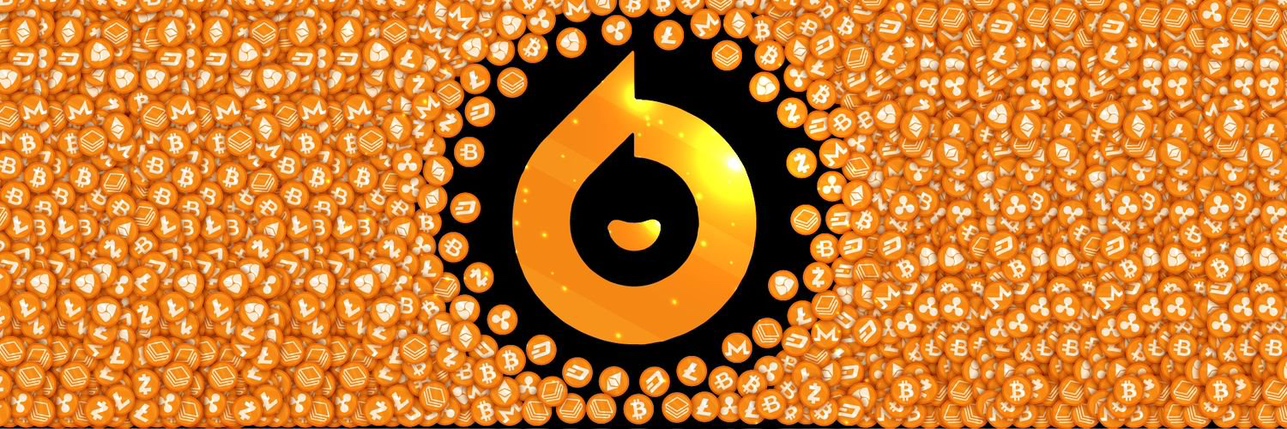
Flux priceFLUX
FLUX/USD price calculator
Flux market Info
Live Flux price today in USD
The cryptocurrency market is experiencing a period of robust activity and significant advancements as of October 18, 2025, marking a dynamic phase characterized by substantial market cap growth, pivotal technological upgrades, and maturing regulatory frameworks. The third quarter of 2025 alone saw the total crypto market capitalization surge by 16.4%, adding over $563 billion to reach an impressive $4 trillion. This resurgence is widely attributed to a 'second leg' of recovery, fueled by both increasing prices and a growing number of participants across the digital asset ecosystem.
Bitcoin’s Enduring Strength Post-Halving Dominates Discussions
The impact of the 2024 Bitcoin halving continues to be a central theme in market analyses. Following the event in April 2024, which reduced miner rewards, Bitcoin has solidified its position amidst growing institutional recognition and a more clearly defined scarcity narrative. While the immediate aftermath of the halving included some price volatility, the overall trend has remained positive, with prices showing resilience. Bitcoin was observed trading around $111,053 at the close of yesterday, October 17, 2025, navigating a market that recently experienced a significant liquidation event earlier in the month, where BTC briefly dipped from above $126,000. Despite such market movements, Bitcoin has maintained a trading channel above $108,000 since mid-July, underscoring its underlying strength and demand.
Ethereum’s Ascendance Fueled by Dencun and ETF Inflows
Ethereum has also been a focal point of market enthusiasm, largely driven by the successful implementation of the Dencun upgrade and the significant influx of institutional capital via spot Ethereum Exchange-Traded Funds (ETFs). The Dencun upgrade, particularly its EIP-4844 feature (proto-danksharding), has dramatically reduced transaction fees on Layer-2 scaling solutions, making the Ethereum network more accessible and efficient for users and developers. This technological advancement, coupled with the launch of spot Ethereum ETFs in 2025, has attracted billions in institutional investment, validating Ethereum’s status as a legitimate and appealing investment vehicle. This confluence of factors led to Ethereum reaching a new all-time high of $4,946 in August 2025. Market analysts are projecting further bullish momentum, with some anticipating ETH to reach $7,500 by the end of 2025, and even more ambitious targets for subsequent years.
Real-World Asset (RWA) Tokenization Takes Center Stage
The tokenization of real-world assets (RWAs) has transitioned from a theoretical concept to a practical and rapidly expanding sector in 2025. This innovation involves representing tangible assets like bonds, real estate, and commodities as digital tokens on blockchain networks, enhancing liquidity, transparency, and accessibility for investors. Institutional adoption in this space has accelerated dramatically, with major financial institutions moving beyond pilot programs to launch scaled tokenized funds and platforms. While stablecoins continue to dominate the existing tokenized asset market, the focus is increasingly shifting towards the explosive growth potential of other RWA categories. Projections indicate that the non-stablecoin RWA market could grow from its current niche to trillions by 2030, driven by clearer regulatory frameworks, heightened institutional demand, and continuous technological innovation. Stellar (XLM), for instance, is actively expanding its ecosystem to facilitate RWA tokenization, aiming to bring billions in tokenized asset value on-chain by the year's end through strategic partnerships and protocol upgrades.
Navigating the Evolving Global Regulatory Maze
Regulatory developments have been a defining characteristic of the crypto market in 2025, with significant progress towards clearer frameworks globally. In the United States, a notable shift towards a more crypto-friendly stance has emerged. The Guiding and Establishing National Innovation for U.S. Stablecoins Act (GENIUS Act) was signed into law, providing a foundational regulatory framework for payment stablecoins. Furthermore, the Securities and Exchange Commission (SEC) has established a Crypto Task Force and is exploring exemptions for tokenization and distributed ledger technology (DLT) securities. Across the Atlantic, the European Union's Markets in Crypto-Assets (MiCA) regulation is in various stages of implementation, while jurisdictions like the United Kingdom, Singapore, and Hong Kong are also advancing their respective digital asset frameworks. These collective efforts signal a global trend towards establishing comprehensive and balanced regulatory environments that aim to foster innovation while ensuring investor protection and market integrity.
The AI-Blockchain Synergy Revolutionizes Operations
A burgeoning and increasingly impactful trend is the convergence of Artificial Intelligence (AI) and blockchain technology. This synergy is creating new opportunities for enhanced data privacy, security, and decentralized intelligence. By integrating AI with blockchain, the market is witnessing the emergence of intelligent automation within decentralized networks, significantly improving data integrity, enabling more autonomous and secure financial systems, and fostering greater accountability and transparency in AI models. This powerful combination is poised to reshape industries by blending AI's analytical and decision-making capabilities with blockchain's immutable and transparent record-keeping, leading to innovations across various sectors.
Stablecoins Continue Record-Breaking Trajectory
Stablecoins have also demonstrated remarkable growth, reaching new all-time highs in market capitalization. In the third quarter of 2025, the total market cap for stablecoins soared to $287.6 billion, primarily propelled by the expansion of USDe and the continued dominance of Tether (USDT). This sustained growth underscores the increasing utility of stablecoins for various functions within the crypto ecosystem, including trading, payments, and as a store of value.
Do you think the price of Flux will rise or fall today?
Now that you know the price of Flux today, here's what else you can explore:
How to buy Flux (FLUX)?How to sell Flux (FLUX)?What is Flux (FLUX)What would have happened if you had bought Flux (FLUX)?What is the Flux (FLUX) price prediction for this year, 2030, and 2050?Where can I download Flux (FLUX) historical price data?What are the prices of similar cryptocurrencies today?Want to get cryptocurrencies instantly?
Buy cryptocurrencies directly with a credit card.Trade various cryptocurrencies on the spot platform for arbitrage.Flux price prediction
When is a good time to buy FLUX? Should I buy or sell FLUX now?
What will the price of FLUX be in 2026?
In 2026, based on a +5% annual growth rate forecast, the price of Flux(FLUX) is expected to reach $0.1316; based on the predicted price for this year, the cumulative return on investment of investing and holding Flux until the end of 2026 will reach +5%. For more details, check out the Flux price predictions for 2025, 2026, 2030-2050.What will the price of FLUX be in 2030?
About Flux (FLUX)
What Is Flux?
Flux is a combination of Blockchain-as-a-Service (BaaS) and decentralized computing solutions, resembling services like AWS. It was founded in 2018 by a team of experienced blockchain developers with the vision to provide a decentralized infrastructure to build Web 3.0 applications, focusing on creating a user-friendly decentralized exchange (DEX) solution. Flux is a fork of ZCash, aiming to improve upon its technology to provide a more efficient and user-friendly network. It has its own Linux-based cloud operating system, FluxOS, and operates on a Proof of Work consensus mechanism, similar to Bitcoin, ensuring secure and decentralized transaction processing.
Flux is renowned for its commitment to enhancing the user experience of decentralized exchanges and has evolved to offer a range of products and services within its ecosystem, including Flux Web3, a comprehensive suite of tools and services for building and accessing decentralized applications (DApps) on the Flux blockchain. Flux’s innovative architecture and its focus on web3 development make it a pivotal player in bridging the gap between web2 and web3 solutions, fostering the technologies of the future.
Resources
Whitepaper: https://whitepaper.app.runonflux.io/
Official Website: https://runonflux.io/
How Does Flux Work?
Flux operates by leveraging its unique blockchain and protocol to create an efficient and user-friendly decentralized exchange (DEX) solution. It employs a unique mining algorithm, FluxNode, designed to incentivize network participation and provide additional security to the network. The Flux blockchain is at the core of the ecosystem, with links to seven other blockchain networks, including Ethereum, BNB Chain, Solana, and Avalanche, ensuring multi-chain compatibility and higher degrees of cross-chain interoperability through FluxOS.
FluxNodes act as gateways between the Flux network and external data sources, allowing developers to build DApps that can interact with real-world data, making them more useful and practical. The network also uses a masternode system, where masternode operators can vote on network proposals and decisions, contributing to the decentralized governance of the network, known as XDAO. This system allows stakeholders to participate in the decision-making process of the network, ensuring that decisions are made in a transparent and decentralized manner.
What Is FLUX Token?
The FLUX token is the native token of the Flux network and plays a crucial role in the ecosystem. It is a utility token used to pay for transaction fees on the network and to access various services and products within the Flux ecosystem, such as FluxNode and the Flux Secure Wallet. FLUX incentivizes network participants, including miners and node operators, to maintain and secure the network. One unique feature of the FLUX token is its deflationary supply mechanism, where a portion of transaction fees paid in FLUX is burned, decreasing the total supply of the token over time and potentially increasing the value of the remaining tokens. FLUX holders also have the ability to vote on proposals and decisions related to the network’s development, contributing to the decentralized and democratic governance of the network.
Flux's Impact on Finance
Flux’s impact on finance is significant, particularly in the realm of decentralized finance (DeFi). It serves as the foundation for the development of new DApps and operations of existing ones, including renowned DeFi apps like Yearn Finance and Aave protocol. Flux’s commitment to providing decentralized, secure, and user-friendly solutions positions it as a transformative force in the financial sector, offering users more control, privacy, and security in their financial transactions and interactions. Its focus on environmental sustainability and energy-efficient algorithms also makes it a more sustainable alternative in the blockchain space, aligning with the growing emphasis on green finance.
Flux’s innovative solutions, commitment to user experience, and focus on web3 and environmental sustainability, set it apart from many other cryptocurrencies and position it as a project with substantial potential in reshaping the financial landscape and driving the future of web3 development.
What Determines Flux's Price?
The price of Flux, like other cryptocurrencies, is determined by a myriad of factors, reflecting the dynamics of the cryptocurrency market. Cryptocurrency price predictions for Flux are influenced by market demand, investor sentiment, and developments within the Flux ecosystem. When cryptocurrency news outlets report positive developments, enhancements, or partnerships related to Flux, it can lead to increased demand and subsequently, a rise in price. Conversely, any negative news or perceived risks can lead to a decline in Flux price. Cryptocurrency analysis and cryptocurrency charts are essential tools for both cryptocurrency enthusiasts and experts to assess and predict Flux price movements, helping them to devise effective cryptocurrency trading strategies.
Market volatility is inherent in the cryptocurrency market, and Flux is no exception. The price of Flux is susceptible to sudden fluctuations, influenced by broader cryptocurrency trends and market sentiments. Cryptocurrency experts and influencers play a significant role in shaping these sentiments, and their opinions and analyses are often considered valuable insights for potential investors. For those looking to buy Flux, it can be acquired on leading exchanges such as Bitget. It is crucial for potential investors to stay abreast of cryptocurrency news, conduct thorough cryptocurrency analysis, and consider cryptocurrency risks before making investment decisions, to determine whether Flux is the best crypto investment for 2023 and beyond.
Investors, especially cryptocurrency beginners, should also consider cryptocurrency security and be wary of potential cryptocurrency scams. Engaging in crypto community discussions, participating in cryptocurrency events, and following cryptocurrency influencers can provide varied perspectives and insights into Flux’s potential as an investment. Additionally, considering cryptocurrency regulation and cryptocurrency tax is crucial when managing a crypto portfolio. As the cryptocurrency adoption continues to grow, staying informed and understanding the market dynamics will be pivotal for anyone involved in the cryptocurrency market, whether they are seasoned traders or new investors.
Bitget Insights



FLUX/USD price calculator
FLUX resources
Tags:
What can you do with cryptos like Flux (FLUX)?
Deposit easily and withdraw quicklyBuy to grow, sell to profitTrade spot for arbitrageTrade futures for high risk and high returnEarn passive income with stable interest ratesTransfer assets with your Web3 walletWhat is Flux and how does Flux work?
Global Flux prices
Buy more
FAQ
What is the current price of Flux?
What is the 24 hour trading volume of Flux?
What is the all-time high of Flux?
Can I buy Flux on Bitget?
Can I get a steady income from investing in Flux?
Where can I buy Flux with the lowest fee?
Related cryptocurrency prices
Prices of newly listed coins on Bitget
Hot promotions
Where can I buy Flux (FLUX)?
Video section — quick verification, quick trading









